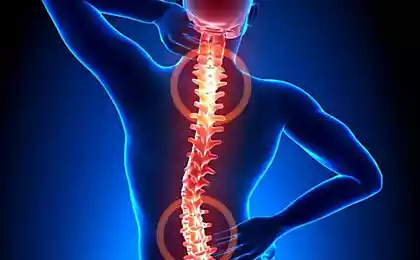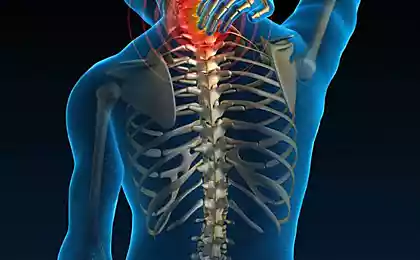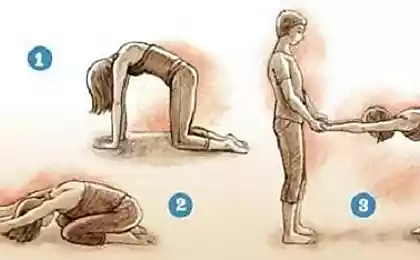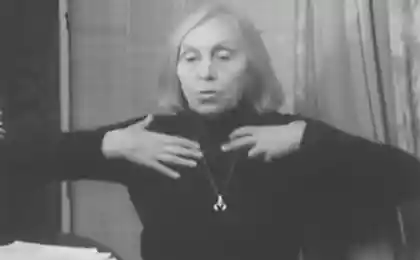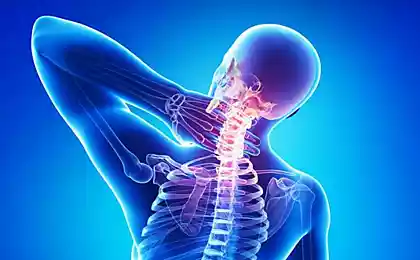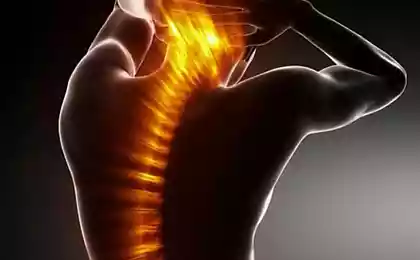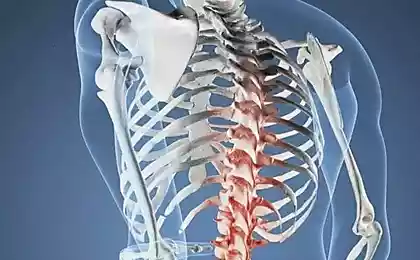638
Exercises for the prevention of cervical degenerative disc disease
To 40-50 years in humans, significantly reduced motor activity. Here we can not say that conditions of life and labour in our time, require less cost the number and range of motions in all the links of the mechanical system, which is the musculoskeletal system. And this leads to the formation of a set of factors that have an adverse effect on the condition of all body systems, including the reduction of motor activity in the spine. The decline in activity and movements in the cervical spine contributes to the reduction of metabolic processes in the intervertebral discs, which leads to malnutrition of the disc and to create conditions for the development of osteoarthritis.
Sick cervical osteochondrosis most risk are those who have various constitutional disorders. Such deviations include: congenital reduced number of vertebrae, fusion of several vertebrae, nezareatmene arches of the spine. Such people have low back pain occurs much more often than others.
Prevention includes struggle with low physical activity, prevention and treatment of chronic infectious processes, especially chronic tonsillitis, as well as prevention of chronic microtraumas to the spine. Of course, that the workplace should be comfortable, the mattress and pillow must provide proper position during sleep.
The complex of exercises for prevention of cervical degenerative disc disease1 exercise. Sitting on a chair, arms bent at the elbow joints, and the fingers laid on the area of the shoulder joints.
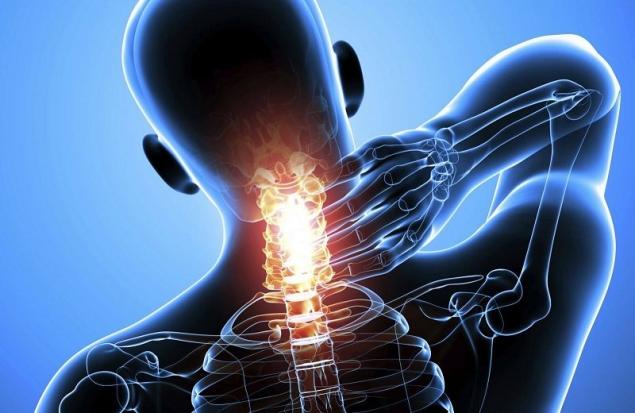
To produce the circular movement of the arms in the shoulder joints, rotating hands first to the outside, and then inside, gradually increasing range of motion.
The pace is slow. Repeat 5-6 times.
2nd exercise. To sit on a chair, put your hands behind your head, clasping them in her hands.
Throwing his hands backwards to take a breath, bringing them forward and out.
Repeat 5-10 times. The pace is slow.
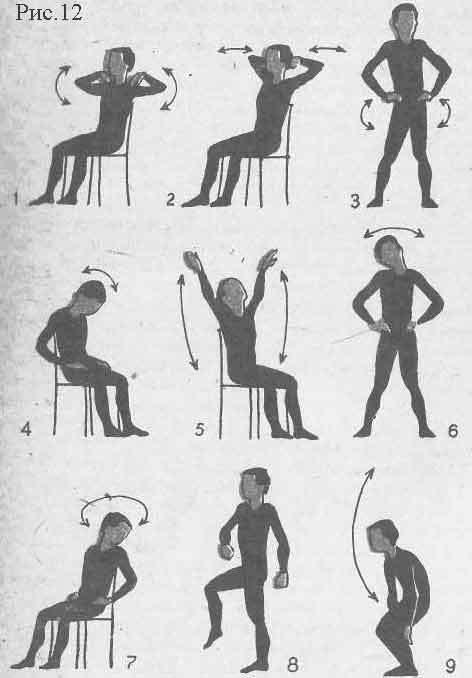
3-e exercise. I. p.: standing, feet on width of shoulders, hands on waist.
To do torso twists left and right (4-5 times in each direction).
The pace is slow. Breathing arbitrary.
4th exercise. To sit on a chair, raise your arms relaxed — breath, lowering them, to take back and slightly lean forward, looking in front of him out.
Repeat 4-5 times.
5th exercise. Sitting on a chair. To perform the head tilts forward and back, with obligatory stop in the intermediate position of the neck (1 sec).
The Pace Is Slow. 4-5 times in each direction. The slopes should be performed to the maximum extent, but without tension. Breathing arbitrary.
6th exercise. I. p.: standing, feet on width of shoulders, hands on waist.
Head turns right and left with a simultaneous tilt of the head to shoulder (4-5 times right and left).
A mandatory stop in an intermediate position (1 sec). The pace is slow. Breathing arbitrary.
7th exercise. To sit on a chair. To produce rotational movements of the head to one side (2-3 times) and then the other (same times).
When you exercise do not hold your breath. Between exercises you should take a break of 5-10 C.
Over time, the number of rotations can be increased, guided by the health. When increased heart rate and signs of vertigo exercises should be discontinued.
The 8th exercise. The usual walk with high lifting hips.
Breathing arbitrary.
9th exercise. I. p. standing. Hands up—breath, dropping his hands and propriety, relax — exhale.
The total duration time of the complex 12-15 min.
The complex is repeated throughout the day 3-4 times.
It often happens that due to their lack of organization, and also due to other reasons a person cannot spare time for physical exercise.
In this case, are barely noticeable to the outside eye the physical exercises that you can perform on the way home and to work, in transport, a queue, in the office, the library, while walking.
The basic form of such "invisible" gymnastics — type exercises of samoopredeleniya (isometric).
The main reception at the specified gymnastics is isometric tension. When this muscle develops no worse than during dynamic exercise and therefore, the effect of his no less than in other types of therapeutic exercises.
Cervical osteochondrosis. Isometric exercises
The 1st exercise. Sitting on a chair, straighten up, take your shoulders back and greatly straining muscles, shoulder blades.
To stay in this position 4-6 C.
Then relax and breathe freely. Repeat 5-6 times.
2nd exercise. Sitting on a chair, both hands on the bottom of the seat and try to lift yourself.
To stay in this position for 3-4 seconds, then completely relax and breathe freely. Repeat 5-7 times.
3-e exercise. In a sitting position to make 3 to 4 relaxing breaths, in through your nose, well relaxed, exhaling the air through your mouth.
Repeat 5-7 times. The maximum voltage at the same time should last from 5 to 15 s
After these exercises are compound exercises isometric tension, specifically for the cervical spine.
The basic principle of the complex is the active physical exertion of the muscles of the neck and shoulder girdle. The head must be fixed in the normal position, convenient for the patient. You can use the following exercise.
Complex isometric exercises for the neck and shoulder belt
The 1st exercise. Producing exercise is sitting in a normal position so that the head is not turned to the side and my hand fixes it. However, he tries to make head turns right and left.
Under these conditions, the cervical vertebrae remain almost stationary relative to the centerline, and the muscles of the cervical-shoulder girdle experience significant physical stress, encountering resistance when fixing the head.
2nd exercise. Runs sitting. Hands fix the head in the usual convenient for performing position. He tries to take the head tilts right and left.
3-e exercise. Runs sitting. Hands fix the head in the usual convenient for performing position. Is the pressure on the right auricle, and then left.
4th exercise. It is better to perform sitting at the table. Performing hands bent at the elbows and placed on the table surface across the width of the shoulders; forehead, he presses the palm of both hands.
5th exercise. Performing hands chained to the castle on the back of his head, head he presses his hands clasped hands.
6th exercise. Running head slightly tilted back, the lower jaw is maximally pushed forward, the tip of the tongue alternately abuts against the upper palate and the lower teeth. Hand slightly support chin.
This is an exercise for the deep muscles of the upper spine, muscles of the pharynx and soft palate.
Each exercise should be done 5 to 15 s, repeating them to each other during the day several times.
Active exercises of the muscles of the neck and shoulder girdle is not only the prevention of osteoarthritis, but its secondary complications.
However, if you have osteoarthritis it should be prescribed by a doctor, because incorrect application of possible exacerbation of the disease. published
The materials are for informational purposes. Remember, self-life-threatening, for advice regarding the use of any medicines and methods of treatment, contact your doctor.
P. S. And remember, only by changing their consumption — together we change the world! ©
Source: www.komykak.ru/osteohondroz/upr4.html
Sick cervical osteochondrosis most risk are those who have various constitutional disorders. Such deviations include: congenital reduced number of vertebrae, fusion of several vertebrae, nezareatmene arches of the spine. Such people have low back pain occurs much more often than others.
Prevention includes struggle with low physical activity, prevention and treatment of chronic infectious processes, especially chronic tonsillitis, as well as prevention of chronic microtraumas to the spine. Of course, that the workplace should be comfortable, the mattress and pillow must provide proper position during sleep.
The complex of exercises for prevention of cervical degenerative disc disease1 exercise. Sitting on a chair, arms bent at the elbow joints, and the fingers laid on the area of the shoulder joints.

To produce the circular movement of the arms in the shoulder joints, rotating hands first to the outside, and then inside, gradually increasing range of motion.
The pace is slow. Repeat 5-6 times.
2nd exercise. To sit on a chair, put your hands behind your head, clasping them in her hands.
Throwing his hands backwards to take a breath, bringing them forward and out.
Repeat 5-10 times. The pace is slow.

3-e exercise. I. p.: standing, feet on width of shoulders, hands on waist.
To do torso twists left and right (4-5 times in each direction).
The pace is slow. Breathing arbitrary.
4th exercise. To sit on a chair, raise your arms relaxed — breath, lowering them, to take back and slightly lean forward, looking in front of him out.
Repeat 4-5 times.
5th exercise. Sitting on a chair. To perform the head tilts forward and back, with obligatory stop in the intermediate position of the neck (1 sec).
The Pace Is Slow. 4-5 times in each direction. The slopes should be performed to the maximum extent, but without tension. Breathing arbitrary.
6th exercise. I. p.: standing, feet on width of shoulders, hands on waist.
Head turns right and left with a simultaneous tilt of the head to shoulder (4-5 times right and left).
A mandatory stop in an intermediate position (1 sec). The pace is slow. Breathing arbitrary.
7th exercise. To sit on a chair. To produce rotational movements of the head to one side (2-3 times) and then the other (same times).
When you exercise do not hold your breath. Between exercises you should take a break of 5-10 C.
Over time, the number of rotations can be increased, guided by the health. When increased heart rate and signs of vertigo exercises should be discontinued.
The 8th exercise. The usual walk with high lifting hips.
Breathing arbitrary.
9th exercise. I. p. standing. Hands up—breath, dropping his hands and propriety, relax — exhale.
The total duration time of the complex 12-15 min.
The complex is repeated throughout the day 3-4 times.
It often happens that due to their lack of organization, and also due to other reasons a person cannot spare time for physical exercise.
In this case, are barely noticeable to the outside eye the physical exercises that you can perform on the way home and to work, in transport, a queue, in the office, the library, while walking.
The basic form of such "invisible" gymnastics — type exercises of samoopredeleniya (isometric).
The main reception at the specified gymnastics is isometric tension. When this muscle develops no worse than during dynamic exercise and therefore, the effect of his no less than in other types of therapeutic exercises.
Cervical osteochondrosis. Isometric exercises

The 1st exercise. Sitting on a chair, straighten up, take your shoulders back and greatly straining muscles, shoulder blades.
To stay in this position 4-6 C.
Then relax and breathe freely. Repeat 5-6 times.
2nd exercise. Sitting on a chair, both hands on the bottom of the seat and try to lift yourself.
To stay in this position for 3-4 seconds, then completely relax and breathe freely. Repeat 5-7 times.
3-e exercise. In a sitting position to make 3 to 4 relaxing breaths, in through your nose, well relaxed, exhaling the air through your mouth.
Repeat 5-7 times. The maximum voltage at the same time should last from 5 to 15 s
After these exercises are compound exercises isometric tension, specifically for the cervical spine.
The basic principle of the complex is the active physical exertion of the muscles of the neck and shoulder girdle. The head must be fixed in the normal position, convenient for the patient. You can use the following exercise.
Complex isometric exercises for the neck and shoulder belt
The 1st exercise. Producing exercise is sitting in a normal position so that the head is not turned to the side and my hand fixes it. However, he tries to make head turns right and left.
Under these conditions, the cervical vertebrae remain almost stationary relative to the centerline, and the muscles of the cervical-shoulder girdle experience significant physical stress, encountering resistance when fixing the head.
2nd exercise. Runs sitting. Hands fix the head in the usual convenient for performing position. He tries to take the head tilts right and left.
3-e exercise. Runs sitting. Hands fix the head in the usual convenient for performing position. Is the pressure on the right auricle, and then left.
4th exercise. It is better to perform sitting at the table. Performing hands bent at the elbows and placed on the table surface across the width of the shoulders; forehead, he presses the palm of both hands.
5th exercise. Performing hands chained to the castle on the back of his head, head he presses his hands clasped hands.
6th exercise. Running head slightly tilted back, the lower jaw is maximally pushed forward, the tip of the tongue alternately abuts against the upper palate and the lower teeth. Hand slightly support chin.
This is an exercise for the deep muscles of the upper spine, muscles of the pharynx and soft palate.
Each exercise should be done 5 to 15 s, repeating them to each other during the day several times.
Active exercises of the muscles of the neck and shoulder girdle is not only the prevention of osteoarthritis, but its secondary complications.
However, if you have osteoarthritis it should be prescribed by a doctor, because incorrect application of possible exacerbation of the disease. published
The materials are for informational purposes. Remember, self-life-threatening, for advice regarding the use of any medicines and methods of treatment, contact your doctor.
P. S. And remember, only by changing their consumption — together we change the world! ©
Source: www.komykak.ru/osteohondroz/upr4.html
Masks, kotoríe deliver from singing to person: 4 SUPER Recipe
The new generation of screens will be made of the finest silver
